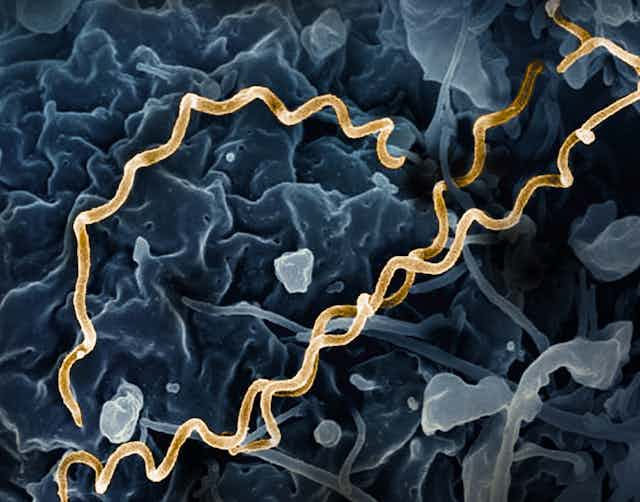Canada has been experiencing an increasing number of syphilis diagnoses since 2016. Numerous provinces have declared outbreaks in recent years, with the highest rates observed in the Northwest Territories, Saskatchewan and Manitoba.
During Sexual Health Week this month, the Chief Public Health Officer of Canada, Dr. Theresa Tam, said the country has experienced an “alarming increase” in syphilis cases.
As an infectious disease physician, I know how important it is that Canadians have answers to common questions about syphilis, why it’s spreading and what the symptoms are.
Syphilis is an infection caused by the bacterium Treponema pallidum, and is transmitted either through sexual exposure or from an infected pregnant woman into the developing fetus, resulting in congenital syphilis.
Why is Canada seeing an increase in cases?
In 2022, there were 13,953 reported syphilis cases, the highest seen in recent times, with rates increasing by 109 per cent compared to 2018. While historically, gay, bisexual and other men who have sex with men remain at high risk of syphilis infections, recent years saw a surge in infections in heterosexual women, comprising of 35 per cent of all cases in 2022. This has led to a 600 per cent increase in the rates of congenital syphilis compared to previous years.
The reasons for this dramatic increase are not fully known, but may be attributed to several factors:
health-care disparity and lack of public health investment in surveillance and prevention as well as mistrust of the health-care system among some populations, such as Indigenous people, Black people and those who use substances,
introduction of highly effective HIV treatment as well as pre-exposure prophylaxis (PrEP) for HIV prevention may result in a decrease in condom use,
easier access to sex via online dating portals, and
rising rates of use of drugs while having sex, called party and play (PnP), coincides with increasing rates of syphilis infections.
Who is most at risk?
Since syphilis is typically a sexually transmitted infection, certain high-risk practices are associated with high risk of syphilis infection:
Individuals who have unprotected sexual intercourse with multiple sex partners.
Commercial sex workers or those who exchange sex for drugs or money.
People living with HIV. Canadian studies have estimated the reported prevalence of syphilis to range between eight and 56 per cent in this group.
Gay, bisexual and other men who have sex with men.
People who have been incarcerated and those who inject recreational substances.
Health Canada has also identified certain high-risk populations, such as those experiencing health and social inequities, predominantly due to lack of accessible health care and screening.
What are the symptoms?
The symptoms of syphilis can be divided into different stages, typically defined by when symptoms begin:
1) Early Syphilis comprises primary and secondary syphilis, which typically occur within weeks to months following the exposure. This also includes early latent syphilis, an asymptomatic stage of the infection.
A) Primary syphilis is characterized by appearance of a painless sore at the site of infection, typically on the genitals or inside the mouth.
B) Secondary syphilis is a systemic illness involving different organ systems. It presents with a diffuse body rash, fever, fatigue and sore throat. Wart-like skin lesions known as condyloma lata, alopecia (hair loss) and hepatitis may also occur in this stage.
C) Early latent syphilis is an asymptomatic stage of the infection within a year of the initial exposure. It is diagnosed with positive blood tests in the absence of any symptoms.
2) Late Syphilis occurs in infected patients who do not receive treatment in the earlier stages and usually develops anywhere from one to 30 years after the initial infection. It is categorized into tertiary syphilis and late latent syphilis.
A) Tertiary syphilis involves chronic inflammation of the body, and may include skin, bones and other internal organs, specifically the cardiovascular system, brain and spinal cord.
B) Late latent syphilis, much like early latent syphilis, is an asymptomatic stage of the infection, but in this case acquired more than a year previously. It is diagnosed based on positive blood tests.
3) Neurosyphilis can occur at any time during the course of infection, and may present in different forms, including meningitis, stroke, or vision or hearing loss.
How is it transmitted?
Syphilis is transmitted through direct exposure to an infectious lesion or sore on the skin (also called a chancre) during sexual intercourse or activity, including oral sex. Additionally, sharing sex toys can also transmit infection between an infected individual and an uninfected one.
Congenital syphilis is acquired when the bacteria is passed through the placenta to a developing fetus, from an untreated pregnant person.
It should be noted that syphilis does not transmit through sharing utensils, toilet seats, bathtubs, swimming pools or clothes because the bacterium dies quickly outside the body.
How is syphilis treated?
Syphilis is an easily treatable infection and duration of antibiotics is determined by the stage of the disease. Early syphilis is treated with a one-time injection of the penicillin antibiotic into the buttock. Late syphilis is treated with three injections of penicillin, each a week apart, over three weeks. Neurosyphilis and syphilis involving the eyes or ears is typically treated with intravenous antibiotics for two weeks.
Alternative options for people who are either allergic to penicillins or cannot tolerate it include oral antibiotics, such as doxycycline or a once-daily intravenous antibiotic, called ceftriaxone.
How can it be prevented?

Syphilis is a preventable disease. It is important for high-risk and sexually active individuals to access counselling about safe sex practices and the importance of screening for sexually transmitted infections (STI screening).
Studies suggest that condoms reduce the risk of syphilis by around 90 per cent when used consistently.
Several recently published studies have reported promising outcomes in STI prevention (including gonorrhea, chlamydia and syphilis) with the use of an oral antibiotic — 200 milligrams of doxycycline — taken once within 24 to 72 hours after high-risk or condom-less sexual exposure. This is called post-exposure prophylaxis.
Additionally, easy and early access to health care and STI screening, as well as availability of post-exposure prophylaxis with the oral antibiotics, is important in preventing transmission to others.
With syphilis cases on the rise in Canada, it is important to know that the infection is treatable. Prevention is key not only to individual health but also to slowing its spread.

